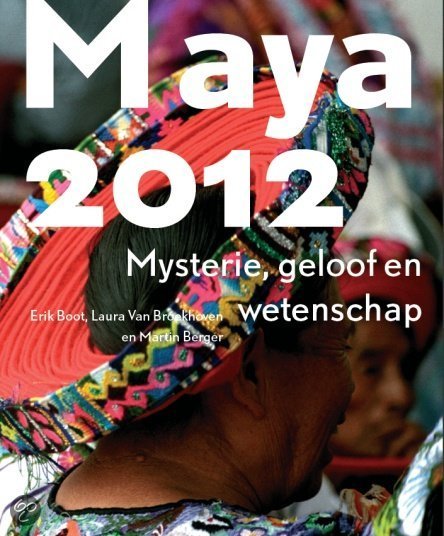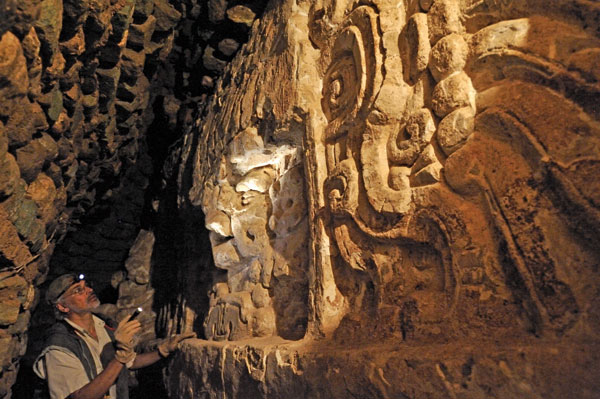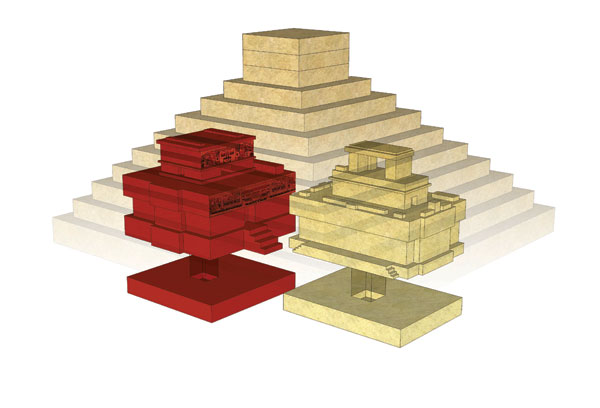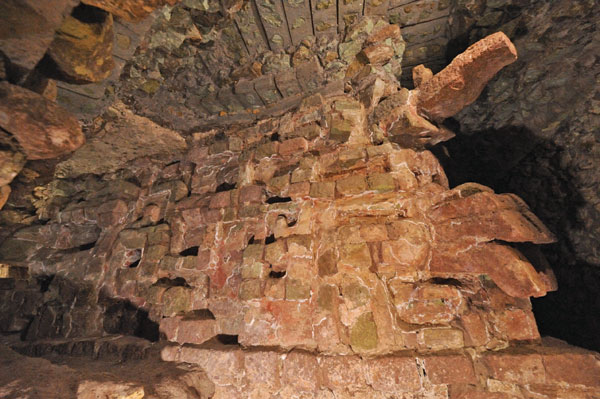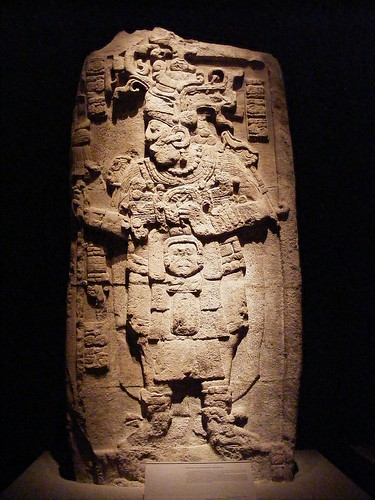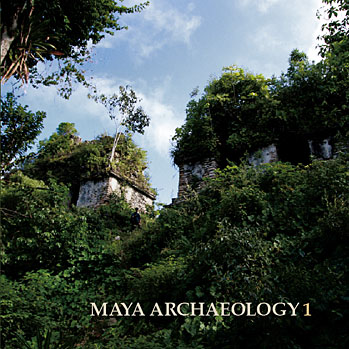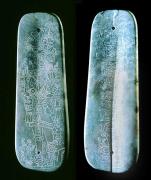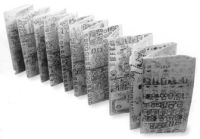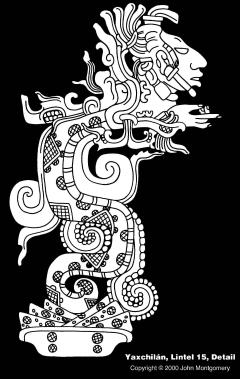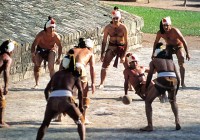Maya News Updates 2016, No. 4: New Maya Exhibit in the
Netherlands - At the Drents Museum, Assen - First Series of Photographs from the Exhibit, taken February 27, 2016
The exhibit "Maya's
- Heersers van het Regenwoud" ("Maya's - Rulers of the Rain Forest")
was opened officially on February 27, 2016, during a reception
well-visited by a host of foreign and local guests. After the reception and official opening one could visit the exhibit. Here I present a first series of photographs of some of the objects shown at the exhibit. Preliminary comments to each photograph written by the photographer.
1. Drents Museum - "Maya's - Heersers van het Regenwoud" - Polychrome Classic period vase, provenance unknown (Motul de San José area), showing court scene; central text informs on the identity (
ubaah "it is the image to ... of ...") of the elite person on the right (
ta?
-ye-la CHAN-na-K'INICH or Tayel Chan K'ihnich), seated on an elevation (throne, bench), and terminates with the paramount title of Motul de San José, K'uhul Ik'a' Ajaw "God-like King of Ik'a'." Tayel Chan K'ihnich is a name of Late Classic king of Motul de San José circa AD 720s-740s and vessels carrying his name have been found at Dos Pilas and Cancuen. These vessels, like the one at the exhibit, may have functioned as elite gifts exchanged at important courtly ceremonies either at Motul de San José itself or at the receiving courts when the Ik'a' king came to visit (Fundación La Ruta Maya, Guatemala) (photograph Erik Boot/MNU 2016)
2. Drents Museum - "Maya's - Heersers van het Regenwoud" - Unprovenanced polychrome
Classic period vase, showing dancing Maize Gods with large back racks and accompanied by dwarfs in the so-called "Holmul Dancer" style (eastern Peten area, Holmul-Naranjo area; on this style see Reents-Budet, 1991,
The “Holmul Dancer” Theme in Maya Art), restored and repainted. Note for instance the inclusion of a near-glyph-by-glyph copy of part of the dedicatory text on Kerr No. 0633 (Fundación La Ruta Maya, Guatemala) (photograph Erik Boot/MNU
2016) (also see Maya News Updates 2011, No. 23
here)
3. Drents Museum - "Maya's - Heersers van het Regenwoud" - Fragment of limestone panel, showing the head of a captured dignitary, the short text provides a so-called Distance Number of 0 days, 0
winal/
winik/
winkil periods of 20 days, 12
haab years of 360 days, and 3
winaakhaab/
k'atun periods of 7,200 days each, after which "happens" (
uhtiiy), but that part of the text is gone (it would have been the Calendar Round date) (Fundación La Ruta
Maya, Guatemala) (photograph Erik Boot/MNU
2016)
4. Drents Museum - "Maya's - Heersers van het Regenwoud" - Limestone drum-shaped altar, provenance unknown, providing an elaborate court scene taking place at Yaxchilan or its direct environs (see Grube and Luin, 2014,
A drum shaped altar from the vicinity of Yaxchilan). Secondary texts identify three of the protagonists and the sculptor (
y-uxul ...-pa ka-..., "it is the sculpture of ..."), the long circular text on top of this altar refers to a mortuary ceremony and terminates with the paramount title of Yaxchilan, K'uhul Pa'chan Ajaw, "God-like King of Pa'chan" (Fundación La Ruta
Maya, Guatemala) (photograph Erik Boot/MNU
2016)
5. Drents Museum - "Maya's - Heersers van het Regenwoud" - Fragment of
limestone panel, showing a captured dignitary, his hands tied with a thick rope. The short text to the right of him reads Ucha'an Yax Tok Bahlam, "The (
u-) guardian (
cha'an) of Yax Tok Bahlam" (Fundación La Ruta
Maya, Guatemala) (photograph Erik Boot/MNU
2016)
6. Drents Museum - "Maya's - Heersers van het Regenwoud" - Limestone statue of a crouching anthropomorphic warrior figure with jaguar mask, large ear spools, and elaborately dressed, some 3 meters long. Original colors remain at places like the ear spools and the mask surrounding the mouth. Found during digging work at a farm in the southwest of Lake Petén Itzá, Peten, Guatemala, some ten years ago (Fundación La Ruta
Maya, Guatemala) (photograph Erik Boot/MNU
2016)
7. Drents Museum - "Maya's - Heersers van het Regenwoud" - Early Classic period cave painting executed on a flowstone fan. Between the two anthropomorphic figures painted black short hieroglyphic texts can be found. One text opens with the Calendar Round date of 9 Ajaw 3 Muwaan. The most likely Long Count date reconstruction for this Calendar Round date is 8.19.10.0.0, the date February 1, in AD 426 (correlation constant 584,285), in the Early Classic period. The date is most probably followed by a so-called Period Ending ceremony, note the "flat hand" (pointing to the left) and the two lines of dots above the hand. Perhaps this is an Early Classic rendition of the
chok ch'aj "to scatter
ch'aj (droplets)" ceremony, known to be associated with Period Endings (compare for instance to Caracol, Stela 1, Front: F1, "flat hand" now pointing downwards, note six parallel lines of dots for
ch'aj) (Fundación La Ruta
Maya, Guatemala; formerly Museo El Príncipe Maya, Cobán, Verapaz, Guatemala, a now defunct museum [since 2011]) (photograph Erik Boot/MNU
2016)
8. Drents Museum - "Maya's - Heersers van het Regenwoud" - Plate the floor of which shows a dancing Maize God, stretching his arms outwards and who has elaborate head ornaments. The circular text, arranged around the dancing Maize God, in the literature known as the "Tikal Dancer" (see for instance Boot, 2003,
An Annotated Overview of “Tikal Dancer Plates” on this iconographic theme and an interpretation of various of the positions of the Maize God) is a non-sensical text (aka. "pseudo-text") which repeats a single sign group over and over (Museo Juan Antonio Valdés, Guatemala) (photograph Erik Boot/MNU
2016)
9. Drents Museum - "Maya's - Heersers van het Regenwoud" - Early
Classic period cache vessel, the top of which is incised with a short five collocation dedicatory text, which opens with the name of the object, followed by the name of the owner or patron and which terminates with the statement
tuk'uhil Ahkan Yaxja', "for (
t-) the (
u-) god (
k'uhil) Ahkan Yaxja' " (Fundación La Ruta
Maya, Guatemala) (photograph Erik Boot/MNU
2016)
10. Drents Museum - "Maya's - Heersers van het Regenwoud" - Three Early
Classic period lidded blackware and burnished vessels, each elaborately decorated with a frontal portrait. Note that the vessels on the left and right each have hieroglyphic signs in the central element of their headdress assemblages, most probably signaling a part of the their names. The lids are incised with symbols that define the water band (Fundación La Ruta
Maya, Guatemala) (photograph Erik Boot/MNU
2016)
11. Drents Museum - "Maya's - Heersers van het Regenwoud" - Late Classic carved limestone panel, part of one of the legs of a monumental carved throne at the archaeological site of Dos Pilas portraying the Classic Maya Sun God, K'ihnich Ajaw "Sun (
k'in) Person(?) (
-ich) King (
ajaw)"(Fundación La Ruta
Maya, Guatemala) (photograph Erik Boot/MNU
2016) (also see Maya News Updates 2012, No. 1
here)
A review of the exhibit "Maya's - Heersers van het Regenwoud/Maya's - Rulers of the Rain Forest," as well as some additional photographs of objects shown at the exhibit, will follow in a next Maya News Updates.







































